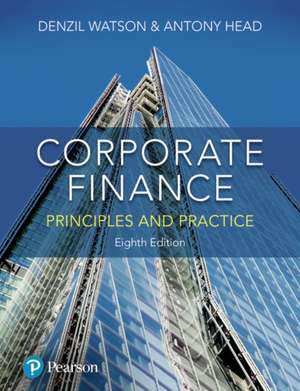Corporate Finance
Autor Antony Head, Denzil Watsonen Limba Engleză Paperback – 5 mar 2019
Preț: 490.19 lei
Preț vechi: 563.44 lei
-13% Nou
Puncte Express: 735
Preț estimativ în valută:
93.83€ • 101.95$ • 78.87£
93.83€ • 101.95$ • 78.87£
Carte disponibilă
Livrare economică 31 martie-14 aprilie
Livrare express 14-20 martie pentru 43.51 lei
Preluare comenzi: 021 569.72.76
Specificații
ISBN-13: 9781292244310
ISBN-10: 1292244313
Pagini: 520
Dimensiuni: 192 x 246 x 22 mm
Greutate: 0.87 kg
Ediția:8 ed
Editura: Pearson Education
ISBN-10: 1292244313
Pagini: 520
Dimensiuni: 192 x 246 x 22 mm
Greutate: 0.87 kg
Ediția:8 ed
Editura: Pearson Education
Notă biografică
Denzil Watson is a Principal Lecturer and Antony Head is an Associate Lecturer in the Sheffield Business School at Sheffield Hallam University. They have extensive experience of teaching corporate finance, managerial finance and strategic financial management over many years and in a wide range of courses at undergraduate, postgraduate and professional level.
Cuprins
Preface Acknowledgements
- The finance function Learning objectives Introduction
- 1.1 Two key concepts in corporate finance
- 1.2 The role of the financial manager
- 1.3 Corporate objectives
- 1.4 How is shareholder wealth maximised?
- 1.5 Agency theory
- 1.6 Corporate governance
- 1.7 Conclusion
- Capital markets, market efficiency and ratio analysis Learning objectives Introduction
- 2.1 Sources of business finance
- 2.2 Capital markets
- 2.3 Capital market efficiency
- 2.4 Assessing financial performance
- 2.5 Conclusion
- Short-term finance and working capital management Learning objectives Introduction
- 3.1 The objectives of working capital management
- 3.2 Working capital policies
- 3.3 Working capital and the cash conversion cycle
- 3.4 Overtrading
- 3.5 Managing inventory
- 3.6 Managing cash
- 3.7 Managing trade receivables
- 3.8 Conclusion
- Long-term finance: equity finance Learning objectives Introduction
- 4.1 Equity finance
- 4.2 The Stock Exchange
- 4.3 Rights issues
- 4.4 Scrip issues, share splits, scrip dividends and share repurchases
- 4.5 Preference shares
- 4.6 Conclusion
- Long-term finance: debt finance, hybrid finance and leasing Learning objectives Introduction
- 5.1 Bonds, loan notes, loan stock and debentures
- 5.2 Bank and institutional debt
- 5.3 International debt finance
- 5.4 Convertible bonds
- 5.5 Warrants
- 5.6 Valuing fixed interest bonds
- 5.7 Valuing convertible bonds
- 5.8 Leasing
- 5.9 Evaluating the financial effects of financing choices
- 5.10 Conclusion
- An overview of investment appraisal methods Learning objectives Introduction
- 6.1 The payback method
- 6.2 The return on capital employed method
- 6.3 The net present value method
- 6.4 The internal rate of return method
- 6.5 Comparing the NPV and IRR methods
- 6.6 The profitability index and capital rationing
- 6.7 The discounted payback method
- 6.8 Conclusion
- Investment appraisal: applications and risk Learning objectives Introduction
- 7.1 Relevant project cash flows
- 7.2 Taxation and capital investment decisions
- 7.3 Inflation and capital investment decisions
- 7.4 Investment appraisal and risk
- 7.5 Appraisal of foreign direct investment
- 7.6 Empirical investigations of investment appraisal
- 7.7 Conclusion
- Portfolio theory and the capital asset pricing model Learning objectives Introduction
- 8.1 The measurement of risk
- 8.2 The concept of diversification
- 8.3 Investor attitudes to risk
- 8.4 Markowitz's portfolio theory
- 8.5 Introduction to the capital asset pricing model
- 8.6 Using the CAPM to value shares
- 8.7 Empirical tests of the CAPM
- 8.8 Conclusion
- The cost of capital and capital structure Learning objectives Introduction
- 9.1 Calculating the cost of individual sources of finance
- 9.2 Calculating the weighted average cost of capital
- 9.3 Average and marginal cost of capital
- 9.4 The CAPM and investment appraisal
- 9.5 Practical problems with calculating WACC
- 9.6 WACC in the real world
- 9.7 The cost of capital for foreign direct investment
- 9.8 Gearing: its measurement and significance
- 9.9 The concept of an optimal capital structure
- 9.10 The traditional approach to capital structure
- 9.11 Miller and Modigliani (I): net income approach
- 9.12 Miller and Modigliani (II): corporate tax
- 9.13 Market imperfections
- 9.14 Miller and personal taxation
- 9.15 Pecking order theory
- 9.16 Conclusion: does an optimal capital structure exist?
- Dividend policy Learning objectives Introduction
- 10.1 Dividends: operational and practical issues
- 10.2 The effect of dividends on shareholder wealth
- 10.3 Dividend irrelevance
- 10.4 Dividend relevance
- 10.5 Dividend relevance or irrelevance?
- 10.6 Dividend policies
- 10.7 Alternatives to cash dividends
- 10.8 Empirical evidence on dividend policy
- 10.9 Conclusion
- Mergers and takeovers Learning objectives Introduction
- 11.1 The terminology of mergers and takeovers
- 11.2 Justifications for acquisitions
- 11.3 Trends in takeover activity
- 11.4 Target company valuation
- 11.5 The financing of acquisitions
- 11.6 Strategic and tactical issues
- 11.7 Divestment
- 11.8 Private equity
- 11.9 Empirical research on acquisitions
- 11.10 Conclusion
- Risk management Learning objectives Introduction
- 12.1 Interest and exchange rate risk
- 12.2 Internal risk management
- 12.3 External risk management
- 12.4 Futures contracts
- 12.5 Options
- 12.6 Swaps
- 12.7 Issues in interest and exchange risk management
- 12.8 Political risk
- 12.9 Conclusion
